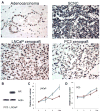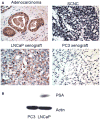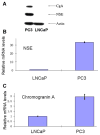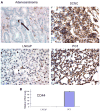PC3 is a cell line characteristic of prostatic small cell carcinoma
- PMID: 21432867
- PMCID: PMC3426349
- DOI: 10.1002/pros.21383
PC3 is a cell line characteristic of prostatic small cell carcinoma
Abstract
Background: The majority of the prostatic cancers are adenocarcinomas characterized by glandular formation and the expression of luminal differentiation markers androgen receptor (AR) and prostate-specific antigen (PSA). Most adenocarcinomas are indolent and androgen-dependent. Hormonal therapy that inhibits AR signaling produces symptomatic relief in patients with advanced and metastatic adenocarcinomas. Prostatic small cell neuroendocrine carcinoma (SCNC) is a variant form of prostate cancer (PC). In contrast to adenocarcinoma, the tumor cells of SCNC do not form glands and are negative for AR and PSA. SCNC is extremely aggressive and does not respond to hormonal therapy. The purpose of this study was to compare the important and relevant features of two most commonly used PC cell lines, LNCaP and PC3, with prostatic adenocarcinoma and SCNC.
Methods: Xenograft tumors of LNCaP and PC3 were prepared and compared with human prostatic adenocarcinoma and SCNC for the expression of key signaling molecules by immunohistochemistry and Western blot analysis.
Results: LNCaP cells express AR and PSA and their growth is inhibited by androgen withdrawal, similar to human prostatic adenocarcinoma. PC3 cells do not express AR and PSA and their proliferation is independent of androgen, similar to SCNC. Adenocarcinoma cells and LNCaP cells are negative for neuroendocrine markers and stem cell-associated marker CD44 while SCNC and PC3 cells are positive. LNCaP cells have identical cytokeratin profiles to adenocarcinoma while PC3 cells have cytokeratin profiles similar to SCNC.
Conclusion: LNCaP cells share common features with adenocarcinoma while PC3 cells are characteristic of SCNC.
Copyright © 2011 Wiley-Liss, Inc.
Figures







Comment in
-
Re: PC3 is a cell line characteristic of prostatic small cell carcinoma.J Urol. 2012 Jul;188(1):325. doi: 10.1016/j.juro.2012.03.074. Epub 2012 May 17. J Urol. 2012. PMID: 22682868 No abstract available.
Similar articles
-
Smoothened loss is a characteristic of neuroendocrine prostate cancer.Prostate. 2021 Jun;81(9):508-520. doi: 10.1002/pros.24122. Epub 2021 May 6. Prostate. 2021. PMID: 33955576 Free PMC article.
-
Pathogenesis of prostatic small cell carcinoma involves the inactivation of the P53 pathway.Endocr Relat Cancer. 2012 May 24;19(3):321-31. doi: 10.1530/ERC-11-0368. Print 2012 Jun. Endocr Relat Cancer. 2012. PMID: 22389383 Free PMC article.
-
NE-10 neuroendocrine cancer promotes the LNCaP xenograft growth in castrated mice.Cancer Res. 2004 Aug 1;64(15):5489-95. doi: 10.1158/0008-5472.CAN-03-3117. Cancer Res. 2004. PMID: 15289359
-
Neuroendocrine cells of prostate cancer: biologic functions and molecular mechanisms.Asian J Androl. 2019 May-Jun;21(3):291-295. doi: 10.4103/aja.aja_128_18. Asian J Androl. 2019. PMID: 30924452 Free PMC article.
-
Androgen-deprivation therapy-induced aggressive prostate cancer with neuroendocrine differentiation.Asian J Androl. 2014 Jul-Aug;16(4):541-4. doi: 10.4103/1008-682X.123669. Asian J Androl. 2014. PMID: 24589459 Free PMC article. Review.
Cited by
-
Evaluation of antibacterial and anticancer properties of secondary metabolites isolated from soil Bacillus spp focusing on two strains of Bacillus licheniformis and Bacillus siamensis.BMC Mol Cell Biol. 2024 Oct 4;25(1):21. doi: 10.1186/s12860-024-00517-5. BMC Mol Cell Biol. 2024. PMID: 39367339 Free PMC article.
-
Prognostic significance of aberrantly silenced ANPEP expression in prostate cancer.Br J Cancer. 2013 Feb 5;108(2):420-8. doi: 10.1038/bjc.2012.549. Epub 2013 Jan 15. Br J Cancer. 2013. PMID: 23322201 Free PMC article.
-
Estrogen and Androgen Hormone Levels Modulate the Expression of PIWI Interacting RNA in Prostate and Breast Cancer.PLoS One. 2016 Jul 14;11(7):e0159044. doi: 10.1371/journal.pone.0159044. eCollection 2016. PLoS One. 2016. PMID: 27414029 Free PMC article.
-
Alchemilla vulgaris agg. (Lady's mantle) from central Balkan: antioxidant, anticancer and enzyme inhibition properties.RSC Adv. 2019 Nov 18;9(64):37474-37483. doi: 10.1039/c9ra08231j. eCollection 2019 Nov 13. RSC Adv. 2019. PMID: 35542286 Free PMC article.
-
The Plant Derived 3-3'-Diindolylmethane (DIM) Behaves as CB2 Receptor Agonist in Prostate Cancer Cellular Models.Int J Mol Sci. 2023 Feb 11;24(4):3620. doi: 10.3390/ijms24043620. Int J Mol Sci. 2023. PMID: 36835033 Free PMC article.
References
-
- Cooperberg MR, Park S, Carroll PR. Prostate cancer 2004: Insights from national disease registries. Oncology (Williston Park) 2004;18:1239–1247. discussion 48–50, 56–58. - PubMed
-
- Huang J, Wu C, di Sant’Agnese PA, Yao JL, Cheng L, Na Y. Function and molecular mechanisms of neuroendocrine cells in prostate cancer. Anal Quant Cytol Histol. 2007;29:128–138. - PubMed
-
- Yuan TC, Veeramani S, Lin MF. Neuroendocrine-like prostate cancer cells: Neuroendocrine transdifferentiation of prostate adenocarcinoma cells. Endocr Relat Cancer. 2007;14:531–547. - PubMed
-
- Vashchenko N, Abrahamsson PA. Neuroendocrine differentiation in prostate cancer: Implications for new treatment modalities. Eur Urol. 2005;47:147–155. - PubMed
Publication types
MeSH terms
Substances
Grants and funding
LinkOut - more resources
Full Text Sources
Other Literature Sources
Medical
Research Materials
Miscellaneous

